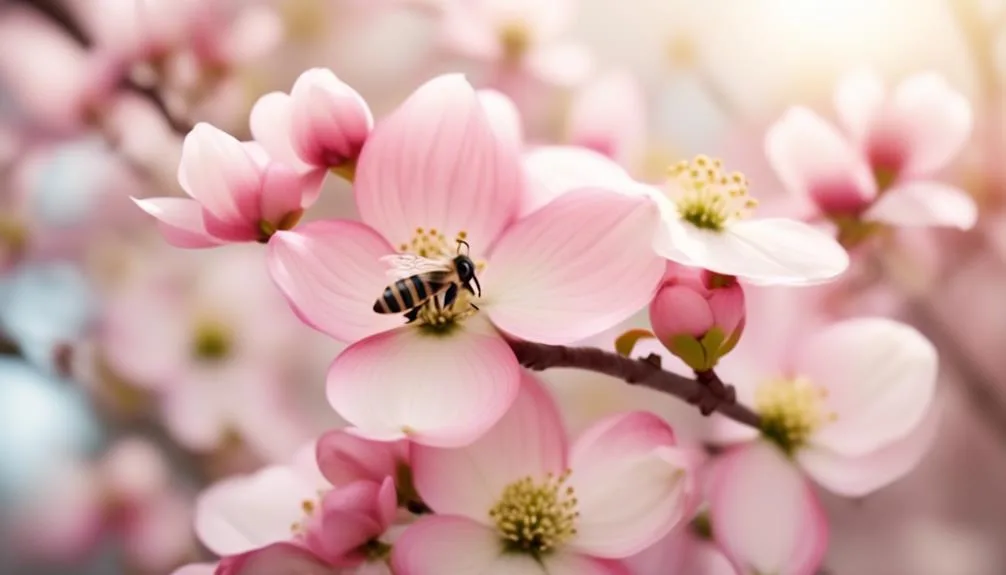Ever noticed bees and butterflies swarming around a blooming dogwood tree? There's a fascinating reason behind it.
The sweet nectar and pollen of dogwood flowers attract these tiny creatures. But what's the secret behind this natural attraction?
Let's explore the intriguing relationship between dogwood trees and these buzzing and fluttering insects.
Stay tuned to uncover the captivating reasons why dogwood trees are a favorite spot for bees and butterflies.
Dogwood Tree Flowers and Nectar
As spring approaches, dogwood tree flowers burst into bloom, attracting bees and butterflies with their sweet nectar. The delicate white or pink blossoms provide essential pollinator support, offering a vital food source for these insects.
Dogwood trees not only enhance the beauty of your garden but also contribute to the ecosystem by supporting local pollinators. When you plant dogwood trees in your garden, you not only add a stunning visual element, but you also actively contribute to the health of the environment.
The presence of these trees can attract a variety of pollinators, which can benefit nearby plants and flowers. By providing a rich source of nectar, dogwood trees bring an array of benefits to your gardening efforts and the surrounding natural habitat.
Attraction to Bees and Butterflies
Attracting bees and butterflies, the sweet nectar of dogwood tree flowers provides essential pollinator support, enhancing the beauty of your garden and contributing to the local ecosystem.
Dogwood trees have evolved to attract these pollinators through a combination of visual and olfactory cues. The bright and showy bracts of the dogwood flowers act as visual signals, attracting butterflies with their vibrant colors. Bees are drawn in by the sweet aroma of the nectar, which is rich in sugars and essential nutrients.
Once the bees and butterflies land on the flowers, they inadvertently collect and transfer pollen, facilitating the tree's reproduction. This mutualistic relationship between dogwood trees and pollinators not only ensures the trees' survival but also enriches your garden with the mesmerizing sight of fluttering butterflies and buzzing bees.
Color and Scent Influence
The captivating hues and alluring scents of dogwood tree flowers play a pivotal role in attracting bees and butterflies to your garden.
Here's why they're so irresistible:
- Plant Genetics: Dogwood trees have evolved to produce flowers in shades that are particularly appealing to pollinators. Their genetic makeup influences the vibrant colors that catch the eye of bees and butterflies.
- Flower Anatomy: The structure of dogwood flowers, including their petals, nectar guides, and reproductive parts, is designed to attract and accommodate pollinators. The color and scent are key components of this anatomy, drawing in these beneficial insects.
- Scent and Color: The sweet fragrance and vivid colors signal to bees and butterflies that the dogwood tree is a source of nectar and pollen, providing them with the sustenance they need while aiding in the tree's pollination.
Understanding the impact of color and scent on these pollinators can help you create a welcoming environment for them in your garden.
Pollen as a Food Source
Indulge in the fascinating role of pollen as a vital food source for the bees and butterflies drawn to dogwood trees in your garden.
As these insects flit from flower to flower, their behavior inadvertently aids in the distribution of pollen. Bees have specialized hairs on their bodies that collect pollen, while butterflies use their long proboscis to sip nectar and inadvertently transfer pollen in the process.
This interaction is crucial for plant reproduction and has a significant ecological impact. The pollen collected by bees and butterflies not only sustains them but also contributes to the fertilization of flowers, ultimately leading to the production of seeds and fruits.
This essential role in the life cycle of plants highlights the intricate relationship between these insects and dogwood trees in your garden.
Environmental Benefits
By fostering a diverse ecosystem, dogwood trees provide numerous environmental benefits, supporting wildlife and contributing to the overall health of the environment. Here are three key ways dogwood trees benefit the environment:
- Pollinator Conservation: Dogwood trees play a crucial role in pollinator conservation by attracting bees and butterflies. The vibrant flowers of the dogwood tree provide nectar, attracting these important pollinators. By supporting these pollinators, dogwood trees contribute to the health and sustainability of the entire ecosystem.
- Ecosystem Support: Dogwood trees contribute to the overall balance of their ecosystems. They provide shelter and nesting sites for birds and other wildlife, helping to maintain biodiversity. Additionally, the fruits of the dogwood tree are a food source for various animals, further supporting the ecosystem.
- Climate Regulation: Dogwood trees, like other trees, play a role in regulating the climate. They absorb carbon dioxide and release oxygen, helping to mitigate the effects of climate change.
These environmental benefits highlight the importance of dogwood trees in maintaining healthy and thriving ecosystems.
Conclusion
In appreciating the dogwood tree's allure, we acknowledge its pivotal role in nurturing bees and butterflies. Through its vibrant blooms and nourishing nectar, the tree enriches the local ecosystem, fostering a healthier and more diverse environment.
Consider the profound impact of such natural partnerships on our surroundings.

My interest in trees started when I first saw the giant sequoias in Yosemite.
I was a teenager then, and I remember thinking, “I need to learn more about this.”
That moment stuck with me.
A few years later, I went on to study forestry at Michigan Tech.
Since graduating, I’ve worked in a mix of hands-on tree care and community education.
I’ve spent over ten years helping people understand how to plant, maintain, and protect the trees in their neighborhoods.
I don’t see trees as just part of the landscape.
They are living things that make a real difference in our daily lives.
